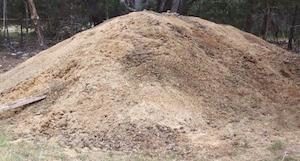Proper Composting is Essential for Horse Farms
by Eleanor Blazer

All horses produce manure, and lots of it. The average 1,000-pound horse produces about 50 pounds of manure a day… and this doesn’t include the bedding. When you consider a horse eats about 25 to 30 pounds of feed a day, the manure production is an amazing feat. (The difference is moisture and body tissue waste.)
The dilemma you face is what to do with the manure and soiled bedding. Research invariably turns up “build a compost bin”.
I have yet to see a compost bin at any of the stables I’ve visited during the last 30 years. I have seen huge piles of manure – some bigger than houses. My mother has a pile almost as old as I am.
Over the years neighbors have removed some of it for their gardens. I once set it on fire – which was not a smart thing to do. It smoldered for weeks. Luckily Mom lives in Ohio which gets a lot of rain.
So, what are some options for getting rid of horse manure?
Environmentalists, cooperative extension services and conservation districts highly recommend composting. Composting reduces the total amount of waste that needs to be removed and concentrates the beneficial nutrients. The heat generated by composting kills parasites, bacteria and insect eggs. Fully composted manure will not attract adult flies. Plus, composted manure is easy to get rid of as people love it for their gardens.
It can take up to eight months for raw manure to become useable compost. The length of time varies depending on the ambient temperature.
But composting takes effort. You can’t just dump the manure in a pile.
A compost bin needs to be constructed on a flat, well-drained piece of ground. It needs to be easily accessible for both filling and removing the compost. Moisture, air flow, and temperature will need to be managed. Moisture is managed by either covering the pile or adding water. Air flow is managed by turning the pile or inserting pipes. Temperature is managed by either reducing the size of the pile or increasing it.
Contact your local conservation district for plans and instructions on building and managing a successful composting operation.
When deciding where to put the manure pile, consider possible contamination of water (ponds, creeks and wells). A 50-foot grass buffer strip is recommended between the pile and water sources. A manure-pile holding area can be helpful. This structure features a concrete floor, berms that offer drainage control, and walls that will keep the pile in one spot. The walls also help with the aesthetics of the stable.
Once the pile reaches immense proportions (or the neighbors start to complain) it’s time to get rid of the pile. The easiest way to get rid of the manure is spreading it on your own land. This requires a tractor, manure spreader, a front-end loader (or a strong back and manure fork) and land.
There are some drawbacks to spreading raw manure and bedding on your land. The horses will not eat grass that has manure on it. If there are weed seeds in the hay you will be seeding your pastures or fields with weed seed. It is possible you will be spreading internal parasites to your pastures (a good de-worming program is mandatory). If the manure is mixed with sawdust or wood shavings the grass or crop in the field will be stunted.
If you don’t want crops stunted, you must treat the daily amount of manure collected. Treat it as you take it from the stall. You need to add nitrogen in the form of ammonium nitrate or ammonium sulfate fertilizer at the rate of ½ cup per day to 40 to 50 pounds of manure. Just sprinkle it on the manure mixture after it’s been loaded in the wheelbarrow or spreader. Urea fertilizer will not work because the nitrogen can be lost into the air. Do not fill in low areas with manure. It is organic, and when wet will turn into a bog. The bacteria and parasites it contains create unsanitary conditions.
Another option to get rid of the manure pile is to pay a farmer or commercial hauler to remove it.
Make sure you remove manure from your turn-out area, dry-lot, or riding arena and preserve the good footing you have provided for your horse.
We all want a neat, clean stable for our horses. With proper management manure should not detract from that goal.
* Earn a Bachelor of Science degree in equine studies or certification as a Professional Horse Trainer or Riding Instructor. Start your new career as a riding instructor, horse trainer, or stable manager. All courses are online. Visit www.horsecoursesonline.com for information.
© 2017
Originally Published February 2018 Issue

Eleanor Blazer was raised training and caring for horses. She learned to ride and care for the horses her family bought and sold. Many of these horses required improved nutrition when they arrived for training. Eleanor’s experience and research has benefited both horses and horse lovers in the field of equine nutrition. An equine nutrition consultant, based in Bulverde, Texas, she keeps busy doing equine nutrition consultations, conducting seminars, and speaking to youth groups about horse care and nutrition. Eleanor is the author of the syndicated column The Way of Horses. She has more than 20 years experience helping and being a mentor to those wanting to know how to provide the very best care and nutrition for our special friend – the horse.






